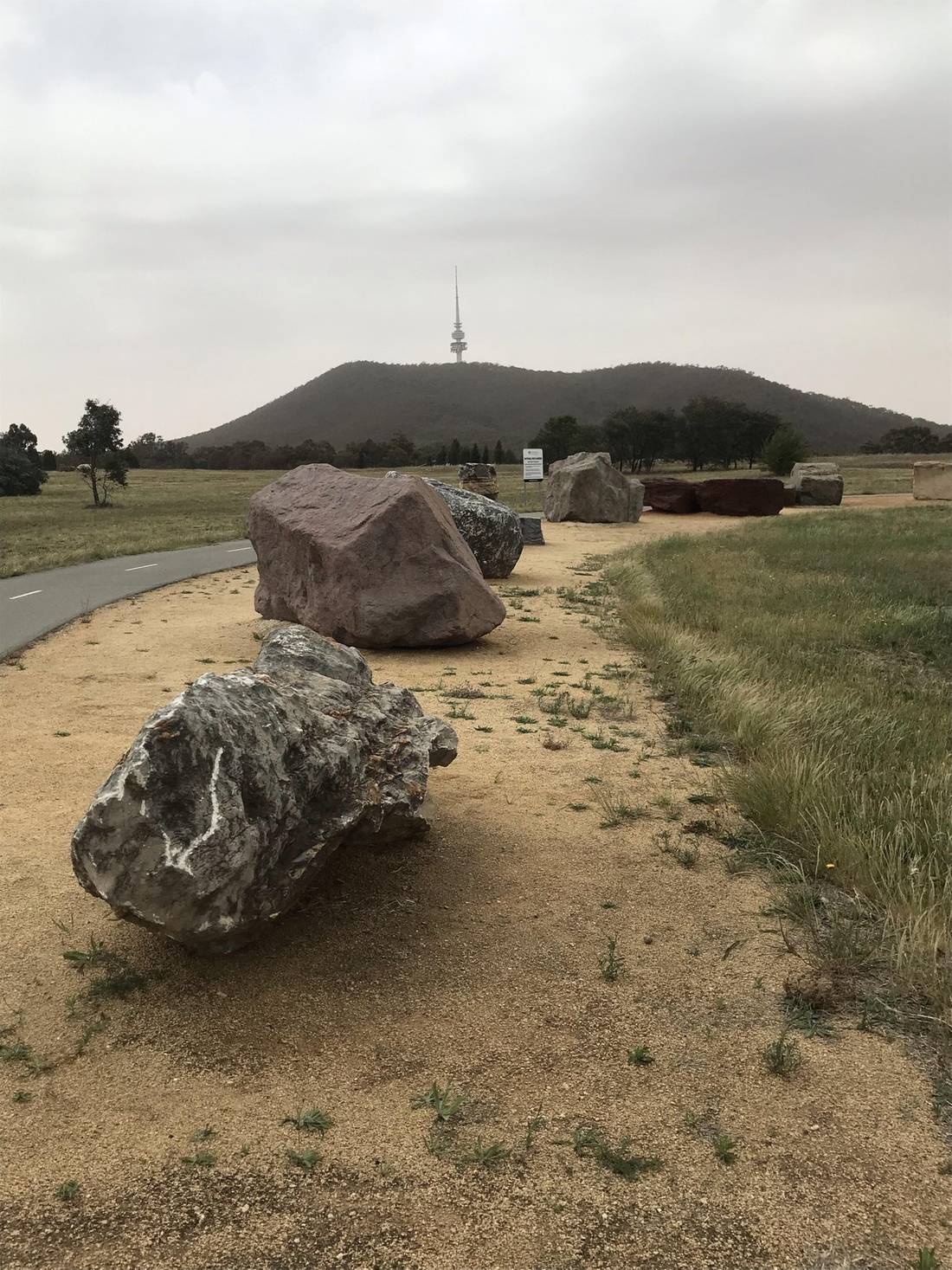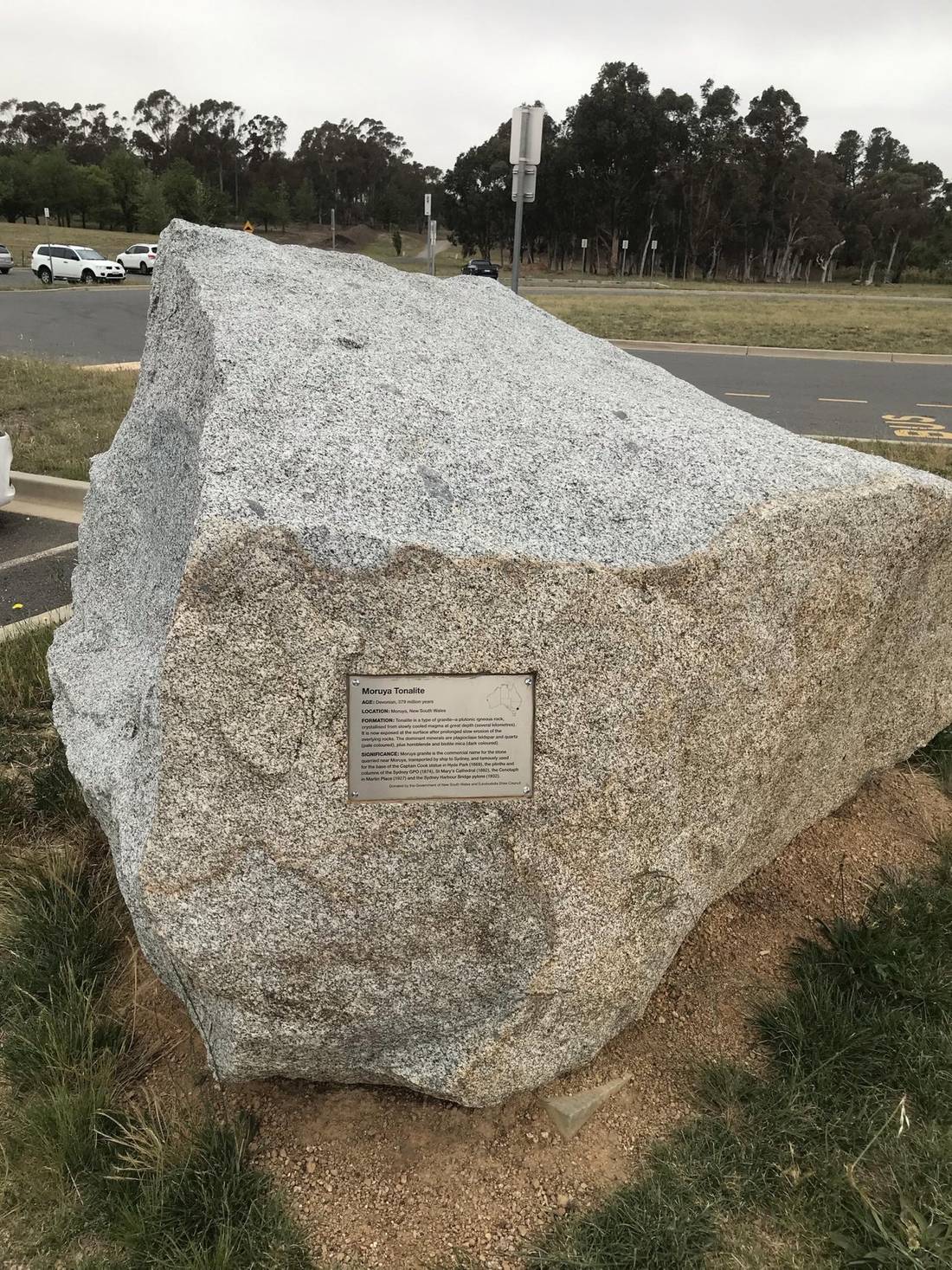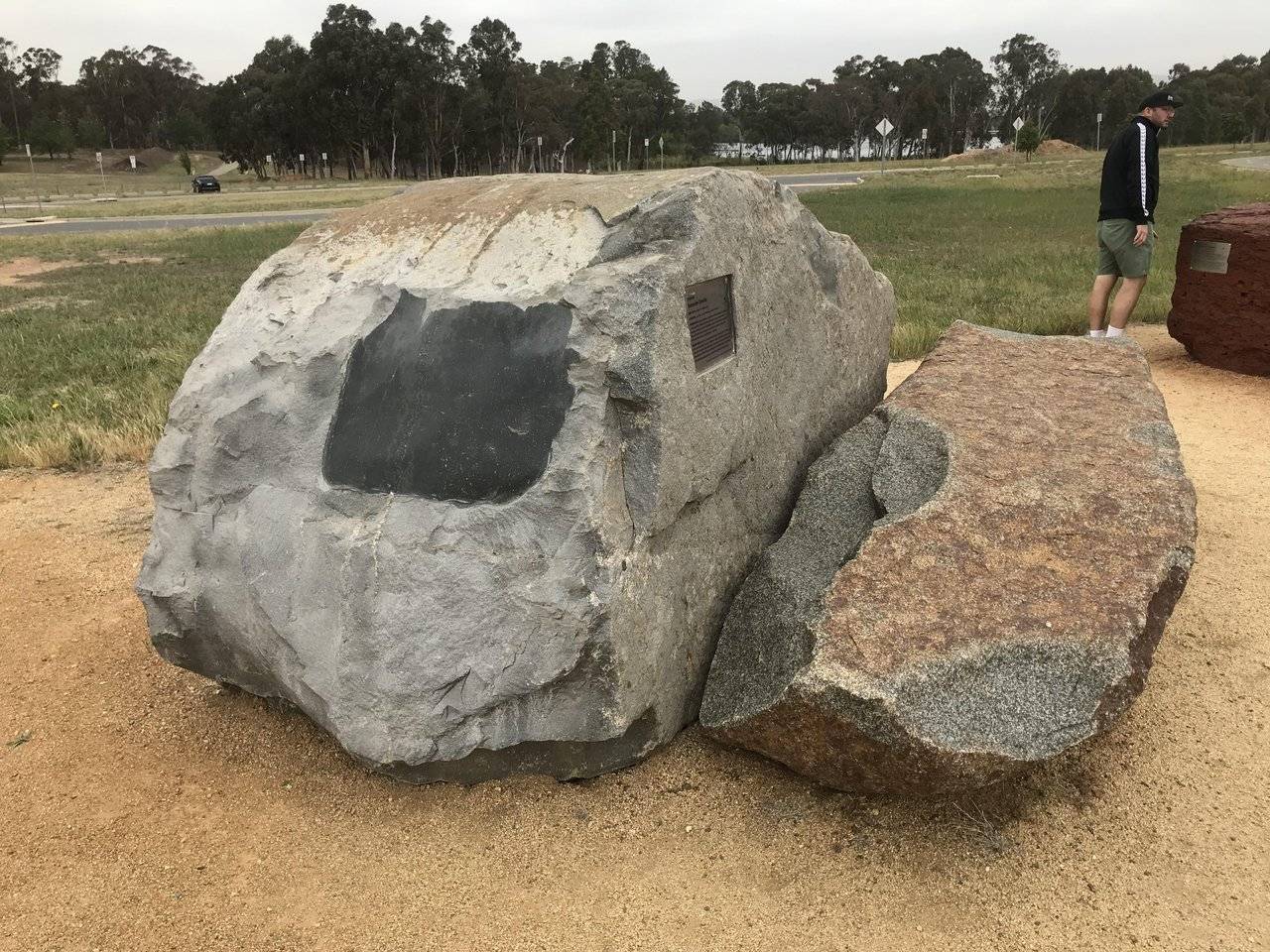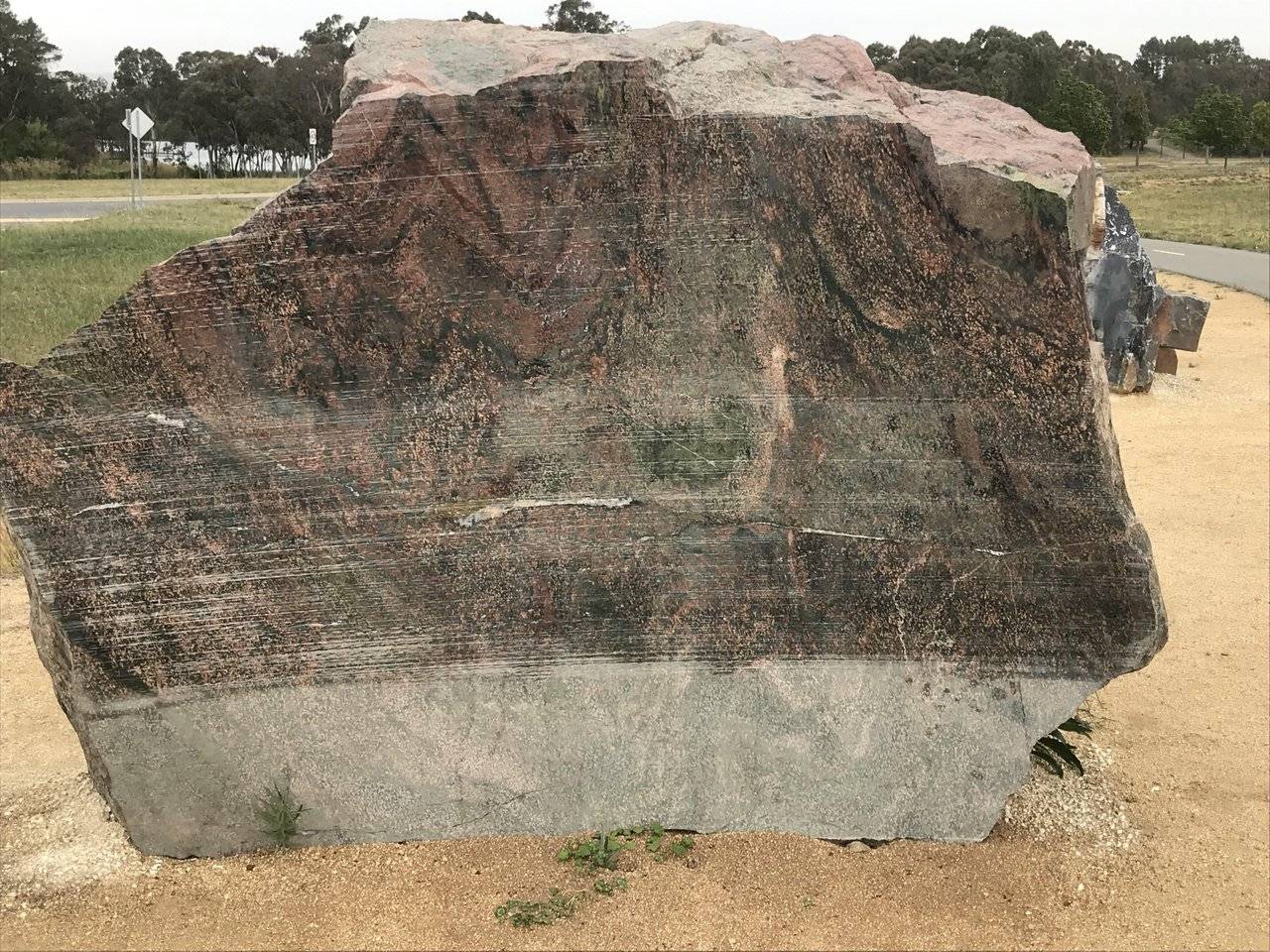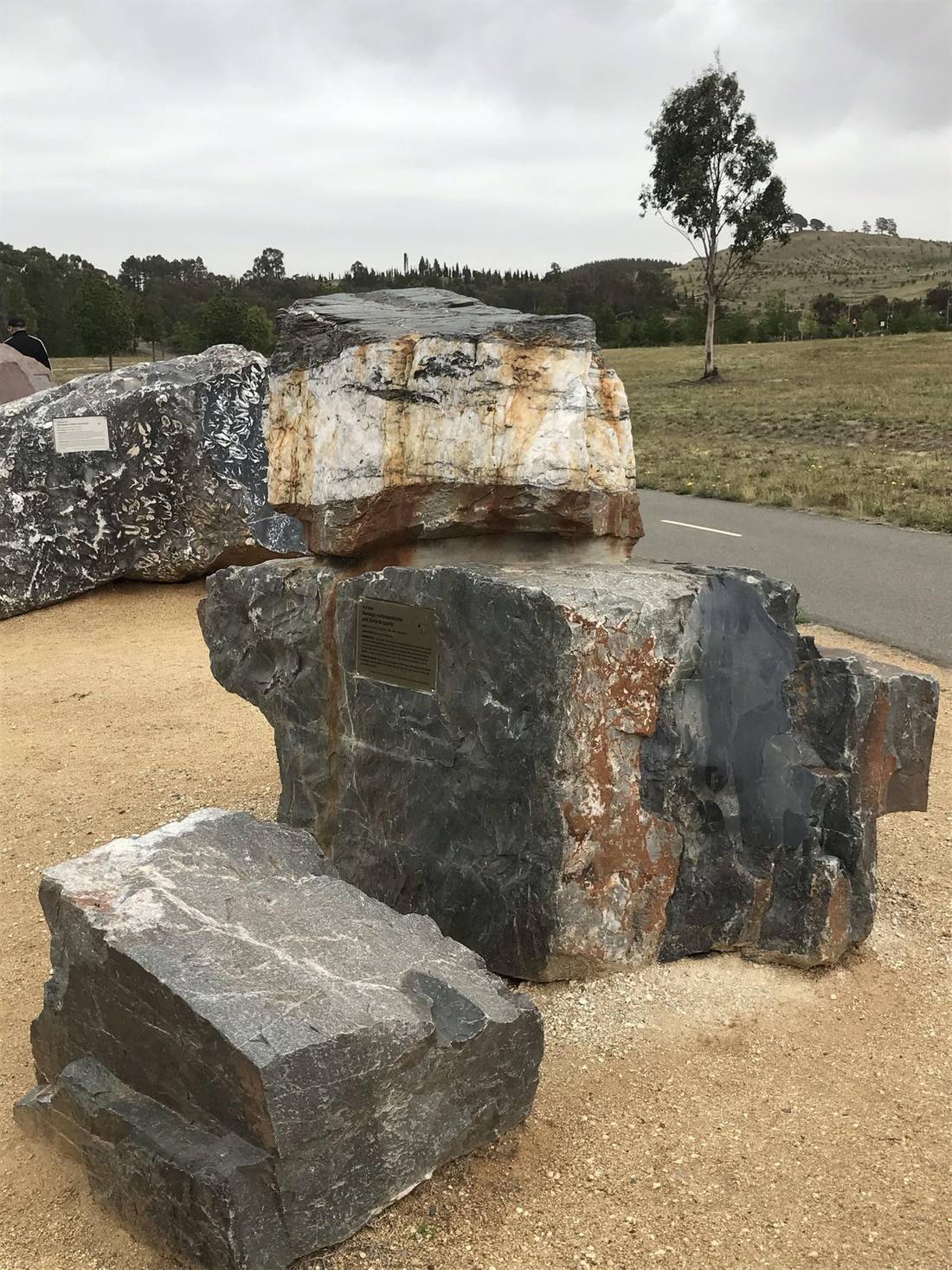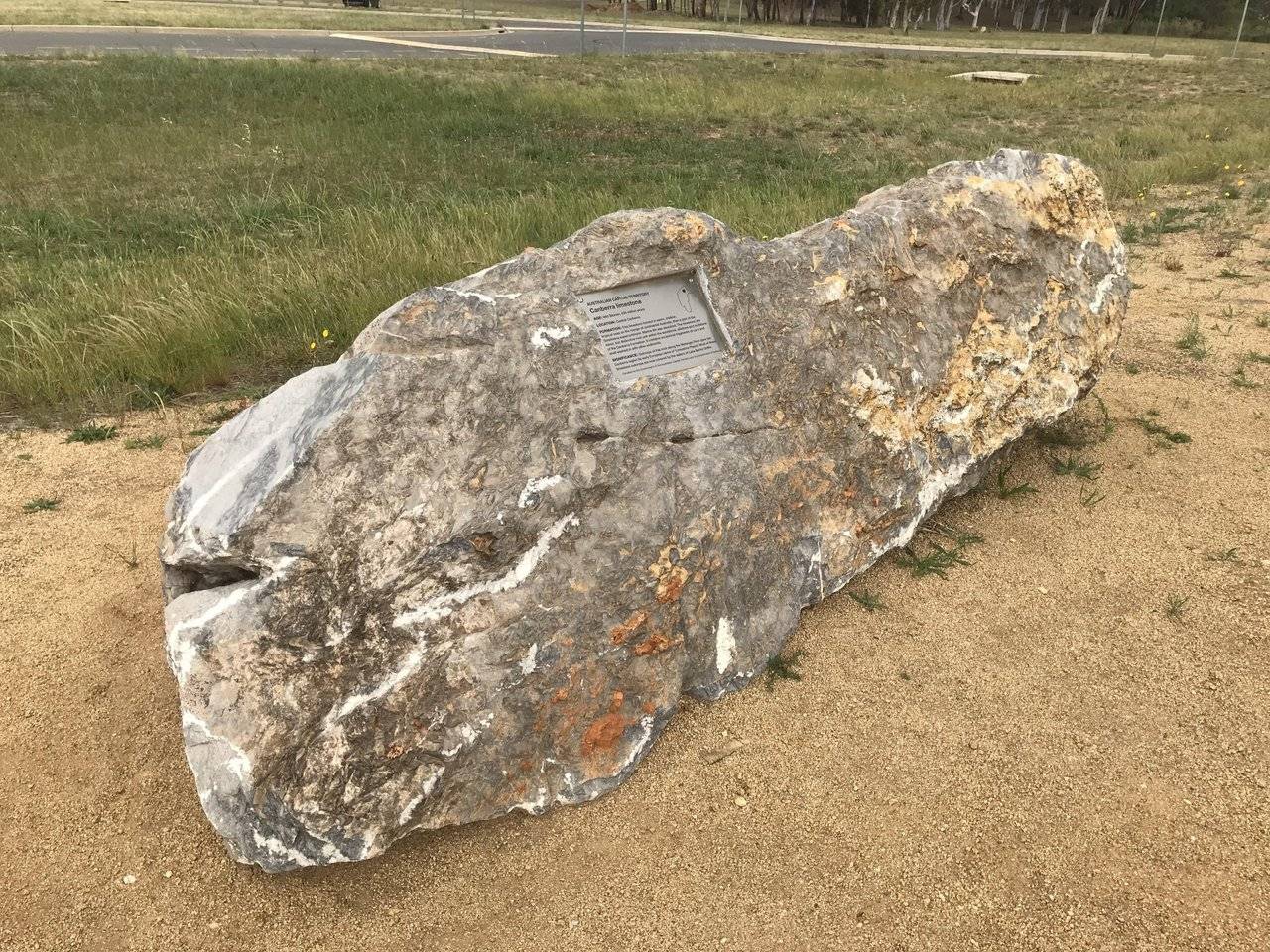We made it home from Australia (a day late and several hundred dollars poorer because of our missed flights)! I will save the conclusion of that story for another day. However, as today is “Boulder Sunday”, I will instead share my recent visit to Australia’s National Rock Garden in Canberra.
The National Rock Garden will celebrate Australia's rich geological heritage in a parkland setting within the national capital, with a permanent display, showcasing the diversity of the rocks, and minerals that contribute so significantly to the nation's landscapes, heritage and prosperity. Source
Thus far, the National Rock Garden is only a small sampling of the planned future site. The current display consists of one large boulder quarried from and representing each Australian state and territory. Each rock is presented in it’s natural form with a small polished area to show visitors the change that polishing brings to the rocks. A placard is embedded on each stone listing it’s material and significance.
Australia is known for its mineral wealth. Mineral mining and related industries are massive contributors to the nation’s economy. The mining industry creates both high paying and high skilled jobs (200,000 directly). source Additionally, the revenue from mining exports makes up 50% of the country’s export earnings. The demand for minerals in overseas markets (particularly China and India) protected Australia’s economy from much of the world wide downturn experienced in the early 2000’s. source
Geology has played a significant role in Australia’s history and continued success.
Moruya Tonalite - New South Wales
From the placard:
- Age: 379 million years
- Location: Moruya, NSW
- Formation: Tonalite is a type of granite - a plutonic igneous rock, crystallized from slowly cooled magma at a great depth. It is now exposed at the surface after prolonged slow erosion of the overlying rocks. The dominant minerals are plagioclase feldspar and quartz plus hornblende and biotite mica.
- Significance: Moruya granite is the commercial name for the stone quarried near Moruya, transported by ship to Sydney, and famously used for the base of the Captain Cook Statue in Hyde Park, the plinths and columns of the Sydney GPO (General Post Office), St. Mary’s Cathedral, the Cenotaph in Martin Place, and the Sydney Harbour Bridge pylons.
Tasmanian Dolerite - Tasmania
From the placard:
- Age: 175 million years
- Location: Leslie Vale south of Hobart, Tasmania
- Formation: During the breakup of Gondwana, dolerite magma was injected as dykes and sills (sheets) into thick sedimentary rocks, covering most of Tasmania. as they cooled and crystallized, regular vertical cracks propagated through the sills forming polygonal columns and the iconic “organ pipes” landscape above Hobart and elsewhere in Tasmania.
- Significance: Dolerite is unusually wide spread in Tasmania, and is referred to as “the rock that made Tasmania.” Altogether, the multiple sills comprise one of the world’s largest magma intrusions. The presence of the same Dolerite sills in Antarctica and South Africa contributed to our understanding of the breakup of the Gondwana supercontinent, of which Australia was the easterly part.
Brockman Iron Formation - Western Australia
From the placard:
- Age: 2490 - 2450 million years
- Location: Hamersley Range, Pilbara region
- Formation: This banded iron formation (BIF) was deposited from dissolved ferrous iron in the early circulating waters of an early global ocean under a reducing atmosphere. The alternating bands show the marine environment see-sawing between oxygen rich and oxygen poor as microbial activity varied.
- Significance: It is the distinctive, spectacular precursor of the many globally significant Pilbara iron ore deposits and thus one of Australia’s most important rocks. Pilbara BIFs are the most exposed, least metamorphosed and least deformed BIFs on earth and contain the world’s largest concentration of iron, amounting to billions of tons of mineable ore.
Oorlano Metasomatite - South Australia
From the placard:
- Age: 1760 million - 1575 million years
- Location: Wallaroo, Yorke Peninsula
- Formation: The heat and fluid from granite intrusions formed this distinctive calc-silicate gneiss from calcareous sedimentary rocks. The colorful minerals include epidote, actinolite and diopside (green); feldspar and haematite (orange and red); and magnetite (black). Quartz-dolomite veins include pyrite and copper-bearing chalcopyrite.
- Significance: This spectacular and valuable “Harlequin Stone” is a widely exported decorative stone but it also expresses the geologic event that formed the giant Olympic Dam orebody and the historic Moonta and Wallaroo copper mines. Its geological history guides further mineral exploration.
Bendigo metasandstone and Ballarat quartz - Victoria
From the placard:
- Age: 480 - 440 million years
- Location: Bendigo and Ballarat, Victoria
- Formation: The lower rock was deposited as sand and mud in the ocean off eastern Australia in the Ordovician. In the early Silurian the sand and mud pile was folded, metamorphosed and injected with hot siliceous fluids to form white quartz veins in the upper rock, often with small amounts of metallic sulphides, and sometimes gold.
- Significance: These rocks are typical of the famous Bendigo and Ballarat Goldfields, which yielded vast riches during Victoria’s gold rushes of the 19th and 20th centuries.
Chinaman Creek Limestone - Queensland
From the placard:
- Age: 390 - 400 million years
- Location: 220km west of Townsville, Queensland
- Formation: This limestone was formed from calcareous mud that accumulated in a tropical, shallow marine environment on the east Australian continental margin. It contains abundant fossil bivalves, corals, sponges and brachiopods, including shells of giant megalodont clams, many of which are preserved in their upright growth position.
- Significance: This abundantly fossilferous limestone can be regarded as a Devonian precursor to the Great Barrier Reef, Queensland’s most iconic natural feature. A spectacular decorative stone, it is being exported around the world. Other Devonian limestone is being used in the manufacture of cement.
Mt. Goyder Syenite - Northern Territory

Ready to Blog & Earn?
With TravelFeed, easily start your own travel blog and earn as you go. It's the smart platform for travelers who want to profit from their passion. Create a free account
From the placard:
- Age: 1825 million years.
- Location: Mt. Bundey Quarry, 120km southeast of Darwin, Northern Territory.
- Formation: A low silica variety of granite, the plutonic rock formed from slowly cooled magma at great depth. It is thought that such magmas arise from partial melting of potassium-rich rocks at the base of the continental crust, often associated with subduction zones. This rock features large red crystals of orthoclase feldspar in a finer matrix.
- Significance: This decorative stone is the red “granite” widely used in Darwin buildings including the Northern Territory Parliament House and Supreme Court.
Canberra Limestone - Australian Capital Territory
From the placard:
- Age: 430 million years
- Location: Central Canberra, Australian Capital Territory
- Formation: This limestone formed in warm, shallow, tropical seas on the continental margin of Australia, then apart of the Gondwana supercontinent. Marine life was abundant. The limestone is a minor, but distinctive rock unit within the sandstone, siltstone and mudstone of the Canberra Formation. It contains occasional fragments of coral and shell washed in with other sediments.
- Significance: Outcrops of this rock along the Molongolo River gave the area its early European name of “Limestone Plains”. Most of these limestone outcrops are now covered by Lake Burley Griffin.

Don't Forget: Get Travel Health Insurance!
To make your trip a worry-free experience, TravelFeed recommends SafetyWing Nomad Insurance. It provides comprehensive health coverage while you travel, so you can focus on exploring, not the unexpected. Get a quote here
We visited this garden mostly as a joke. It is essentially just a few rocks in the middle of a field with a parking lot attached. However, the information on each rock ended up being pretty interesting. The Geological Society of Australia is also raising funding for a future expansion of the garden. It is their vision that:
The National Rock Garden will be a tribute to this (Australia’) geological legacy, displaying rock specimens from across the continent in a single location in the nation’s capital city, Canberra. The National Rock Garden will be a world-class educational and tourist destination for all Australians as well as for international visitors. There will be more than one hundred spectacular rock specimens on display, carefully chosen to tell interesting stories about Australia’s geological heritage. source
I look forward to seeing the growth of the garden in years to come.
All photos are my own. Taken November 2019 on an iPhone 7.
Proud Member of:
Travel Resources for your trip to Australia
Recommended by TravelFeed
Flights: We recommend checking Kiwi.com to find the best and cheapest flights to Australia.
Accomodation: Explore the best places to stay in Australia on Booking.com, Agoda and Hostelworld.
Travel Insurance: Medical emergencies abroad can be pricey, but travel health insurance is not. We always use SafetyWing for affordable and reliable coverage.
Car Rental: For hassle-free car hiring, DiscoverCars is our trusted choice with a wide selection of vehicles.
Internet: Got an eSIM compatible phone? Airalo is perfect for reliable internet access during your trip. Just install it before you go, and you're set!
Day Trips & Tours: We recommend GetYourGuide for a variety of well-organized and enjoyable activities.
Travel Planner: Need a hand planning? Our free travel planner chatbot is your personal guide to Australia. Chat now.
Disclosure: Posts on TravelFeed may contain affiliate links. See affiliate disclosure.

